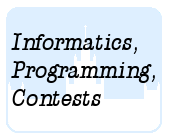Подразделы
Другие разделы
| 858. Glenbow Museum |
| 859. The Sky is the Limit |
| 860. Steam Roller |
Дата и время
06/12/2025 04:40:59
 857. Always an Integer
857. Always an Integer
 Always an Integer
Always an Integer
 Обработка строк
Обработка строкОлимпиадные задачи на английском языке

| 16/04/2008 | Занятие 21 (B) |
Ограничения: время – 2s/4s, память – 64MiB Ввод: input.txt или стандартный ввод Вывод: output.txt или стандартный вывод 
Послать решение Blockly Посылки Темы Где Обсудить (0)
Combinatorics is a branch of mathematics chiefly concerned with counting discrete objects. For instance, how many
ways can you pick two people out of a crowd of `n` people? Into how many regions can you divide a circular disk by
connecting `n` points on its boundary with one another? How many cubes are in a pyramid with square layers ranging
from 1x1 to `n`x`n` cubes?

Many questions like these have answers that can be reduced to simple polynomials in `n`. The answer to the first
question above is `(n(n-1))/2`, or `(n^2-n)/2`. The answer to the second is `(n^4-6n^3+23n^2-18n+24)/24`. The answer to
the third is `(n(n+1)(2n+1))/6`, or `(2n^3+3n^2+n)/6`. We write these polynomials in a standard form, as a polynomial
with integer coefficients divided by a positive integer denominator.
These polynomials are answers to questions that can have integer answers only. But since they have fractional
coefficients, they look as if they could produce non-integer results! Of course, evaluating these particular
polynomials on a positive integer always results in an integer. For other polynomials of similar form, this is not
necessarily true. It can be hard to tell the two cases apart. So that, naturally, is your task.
Input
The input consists of multiple test cases, each on a separate line. Each test case is an expression in the form (`P`)/`D`,
where `P` is a polynomial with integer coefficients and `D` is a positive integer denominator. `P` is a sum of terms of the
form `C`n^`E`, where the coefficient `C` and the exponent `E` satisfy the following conditions:
- `E` is an integer satisfying `0\ ≤\ E\ ≤\ 100`. If `E` is 0, then `C`n^`E` is expressed as `C`. If `E` is 1, then `C`n^`E` is expressed as `C`n, unless `C` is 1 or –1. In those instances, `C`n^`E` is expressed as n or -n.
- `C` is an integer. If `C` is 1 or –1 and `E` is not 0 or 1, then the `C`n^`E` will appear as n^`E` or -n^`E`.
- Only non-negative `C` values that are not part of the first term in the polynomial are preceded by +.
- Exponents in consecutive terms are strictly decreasing.
- `C` and `D` fit in a 32-bit signed integer.
See the sample input for details.
Input is terminated by a line containing a single period.
Output
For each test case, print the case number (starting with 1). Then print "Always an integer" if the test case
polynomial evaluates to an integer for every positive integer `n`. Print "Not always an integer" otherwise. Print
the output for separate test cases on separate lines. Your output should follow the same format as the sample output.
Sample Input
(n^2-n)/2 (2n^3+3n^2+n)/6 (-n^14-11n+1)/3 .
Output for the Sample Input
Case 1: Always an integer Case 2: Always an integer Case 3: Not always an integer

 Начало
Начало